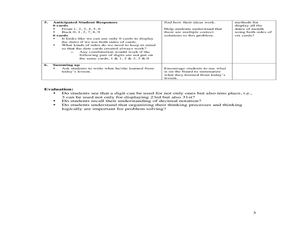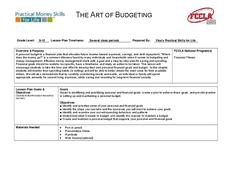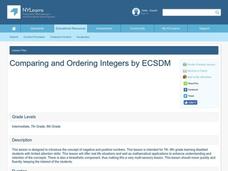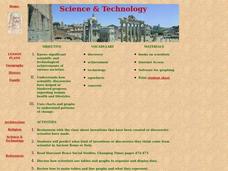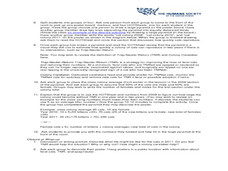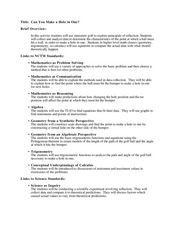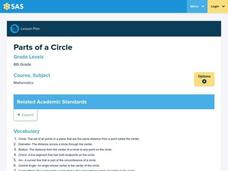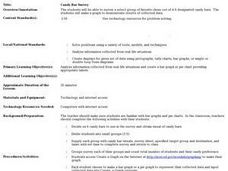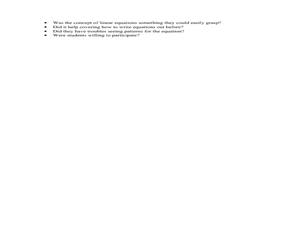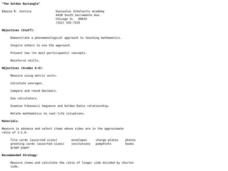Curated OER
Compass Crusaders
Learners discover how to use a compass and how to use that knowledge in the field while applying orienteering and mathematical skills.
Curated OER
Using Math to Draw the Mayflower
Third graders access information from a website about the Pilgrims trip on the Mayflower and discuss the number of people on the ship and the time they spent on the ship. They draw, label and measure the Mayflower to perspective.
Curated OER
How many cards do we need to display the dates of the month on the wall?
Students determine how many number cards are needed to display the dates of the month. In this place value notation lesson, students write numbers on blank cards to see how many are needed of each number to makes all the dates...
Curated OER
I.O.U.
Students explore adding and subtracting positive and negative numbers in the context of money. In this computation lesson, students use play money and IOU's to model various mathematical algorithms.
Curated OER
The Art of Budgeting
Students create a plan to achieve personal and financial goals. In this budgeting goals lesson, students identify their sources of income and discuss being financially independent. Students record their monthly expenditures and present a...
Curated OER
Comparing and Ordering Integers
Students compare and order integers on an umber line. In this algebra lesson, students differentiate between positive and negative numbers. They plot point in the correct order on a number line.
Curated OER
Area of irregular Polygons: Historical Motivator - Lewis and Clark Adventure
Seventh graders find the area of irregular polygons. In this lesson on calculating area, 7th graders use the adventures of Lewis and Clark as motivation to learn how to calculate the area of irregular polygons.
Curated OER
School Yard Park/ Ecosystem
Fifth graders examine ecosystems in their schoolyard. In this nature and ecosystem lesson, 5th graders map their schoolyard into workable plots. They classify plants and animals found in the plot. They revisit their site every two weeks...
Curated OER
Finding Mass
Student measure mass to discover how pennies have changed in their composition. In this measurement lesson, 8th graders investigate through an open-ended problem to discover how the US pennies composition changed in the 1980's.
Curated OER
Cut, Construct and Think
Students complete geometrical shapes construction activities. In this geometrical concepts activity, students cut shapes from a worksheet to create a geometrical study activity. Students analyze their shapes and complete a table....
Curated OER
Science and Technology
Students research inventions that have been created. In this historical technology lesson, students read the Harcourt Brace social studies textbook and discuss how inventors used graphs to display data. Students create a table to write...
Curated OER
The Tale of the Feral - Care and Multiplication of Feral Cats
Students differentiate between a feral cat and a domesticated cat. For this cat lesson plan, students use the scientific method, calculate averages, solve story problems, and learn how a caretaker can help a feral colony live safely.
Curated OER
Electric Circuits
Students explore energy by completing an electricity worksheet. In this conductors lesson, students define the energy related vocabulary terms circuit, electronics, conductor and semi-conductor before examining computer chips in class....
Curated OER
Will Exams Be Cancelled?
If the flu outbreak continues, exams will have to be canceled. Investigate the properties of exponential and logarithmic functions. In this algebra lesson, students use the TI to examine and differentiate between exponential growth and...
Curated OER
Can You Make a Hole in One?
Students relate miniature golf to reflection of an image. In this algebra lesson plan, students collect and graph data as they study linear equations. They apply properties of graphing to solve real life scenarios.
Curated OER
How Sharp Is Your Memory?
Students play a memory game as they explore reasoning. In this algebra lesson, students identify concepts using pictures and words. They model real life scenarios using hands on manipulatives.
Curated OER
Mazes and Labyrinths
Learners evaluate directions by participating in a maze activity. In this labyrinth lesson, students identify the history of mazes and labyrinths and utilize Google Earth to examine real life mazes. Learners create their own mazes...
Curated OER
Parts of a Circle
Sixth graders use yarn, paper plate, and other materials to identify parts of a circle. In this parts of a circle lesson plan, 6th graders identify the circumference, radius, diameter, and other parts of a circle.
Curated OER
Similarity
Students engage in a lesson that is concerned with the concept of similarity. This takes higher order thinking skills and being able to separate into categories. Specifically in this lesson they are introduced to the scale and how it is...
Curated OER
Candy Bar Survey
Second graders investigate the skill of graphing data by using candy bars to create context for the lesson. They use technology for graphing and organizing information like a spreadsheet. The lesson includes a resource link to aid in the...
Curated OER
The Fuelish Fact Finding
Learners define fluctuation and the price of food. In this algebra instructional activity, students create a budget to live on based on their living expenses. They create a chart and explore the cause and effect of real life scenarios.
Curated OER
Every Graph Tells A Story
Seventh graders explore linear equations. In this graphing activity, 7th graders explore constant rates of change. Students discover the real-life application of graphs and demonstrate their ability to read graphs and write...
College Board
Seeing Is Believing
Students read about AP calculus online. In this calculus lesson, students learn real life usage for calculus. They read about instructors and their experience teaching and incorporating calculus into the real world.
Curated OER
The Golden Rectangle
Students explore the concept of the golden ratio. In this golden ratio lesson, students measure objects to determine if their measurements fit the golden ratio. Students calculate the average measurements of the class.


